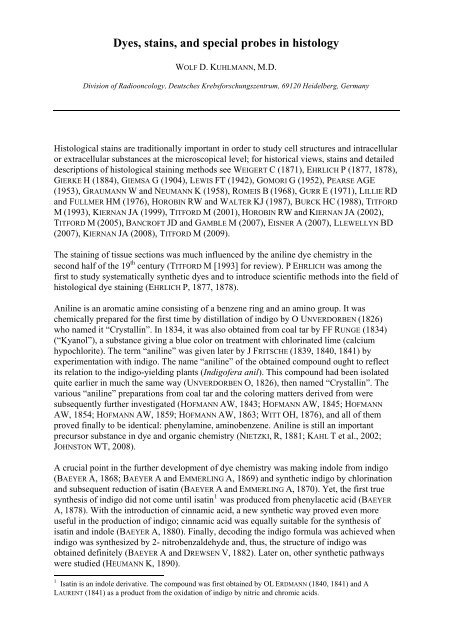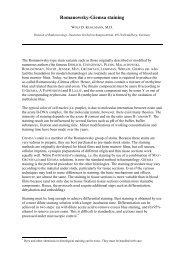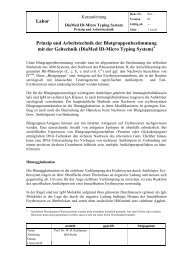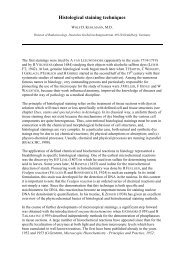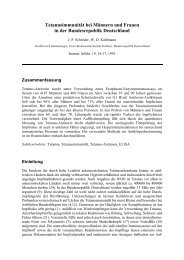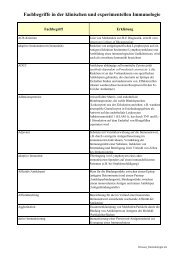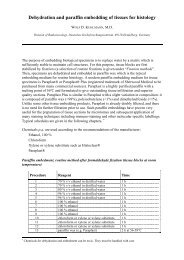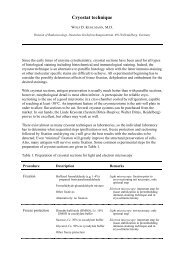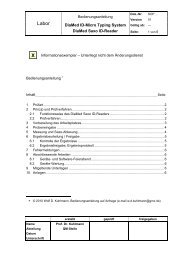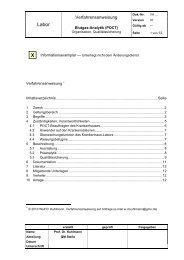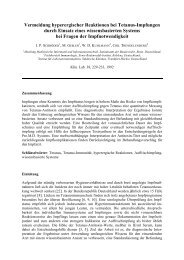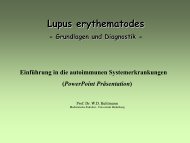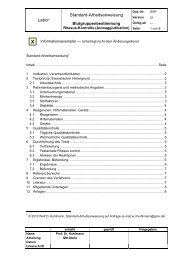Dyes, stains, and special probes in histology
Dyes, stains, and special probes in histology
Dyes, stains, and special probes in histology
Create successful ePaper yourself
Turn your PDF publications into a flip-book with our unique Google optimized e-Paper software.
<strong>Dyes</strong>, <strong>sta<strong>in</strong>s</strong>, <strong>and</strong> <strong>special</strong> <strong>probes</strong> <strong>in</strong> <strong>histology</strong>WOLF D. KUHLMANN, M.D.Division of Radiooncology, Deutsches Krebsforschungszentrum, 69120 Heidelberg, GermanyHistological <strong>sta<strong>in</strong>s</strong> are traditionally important <strong>in</strong> order to study cell structures <strong>and</strong> <strong>in</strong>tracellularor extracellular substances at the microscopical level; for historical views, <strong>sta<strong>in</strong>s</strong> <strong>and</strong> detaileddescriptions of histological sta<strong>in</strong><strong>in</strong>g methods see WEIGERT C (1871), EHRLICH P (1877, 1878),GIERKE H (1884), GIEMSA G (1904), LEWIS FT (1942), GOMORI G (1952), PEARSE AGE(1953), GRAUMANN W <strong>and</strong> NEUMANN K (1958), ROMEIS B (1968), GURR E (1971), LILLIE RD<strong>and</strong> FULLMER HM (1976), HOROBIN RW <strong>and</strong> WALTER KJ (1987), BURCK HC (1988), TITFORDM (1993), KIERNAN JA (1999), TITFORD M (2001), HOROBIN RW <strong>and</strong> KIERNAN JA (2002),TITFORD M (2005), BANCROFT JD <strong>and</strong> GAMBLE M (2007), EISNER A (2007), LLEWELLYN BD(2007), KIERNAN JA (2008), TITFORD M (2009).The sta<strong>in</strong><strong>in</strong>g of tissue sections was much <strong>in</strong>fluenced by the anil<strong>in</strong>e dye chemistry <strong>in</strong> thesecond half of the 19 th century (TITFORD M 1993 for review). P EHRLICH was among thefirst to study systematically synthetic dyes <strong>and</strong> to <strong>in</strong>troduce scientific methods <strong>in</strong>to the field ofhistological dye sta<strong>in</strong><strong>in</strong>g (EHRLICH P, 1877, 1878).Anil<strong>in</strong>e is an aromatic am<strong>in</strong>e consist<strong>in</strong>g of a benzene r<strong>in</strong>g <strong>and</strong> an am<strong>in</strong>o group. It waschemically prepared for the first time by distillation of <strong>in</strong>digo by O UNVERDORBEN (1826)who named it “Crystall<strong>in</strong>”. In 1834, it was also obta<strong>in</strong>ed from coal tar by FF RUNGE (1834)(“Kyanol”), a substance giv<strong>in</strong>g a blue color on treatment with chlor<strong>in</strong>ated lime (calciumhypochlorite). The term “anil<strong>in</strong>e” was given later by J FRITSCHE (1839, 1840, 1841) byexperimentation with <strong>in</strong>digo. The name “anil<strong>in</strong>e” of the obta<strong>in</strong>ed compound ought to reflectits relation to the <strong>in</strong>digo-yield<strong>in</strong>g plants (Indigofera anil). This compound had been isolatedquite earlier <strong>in</strong> much the same way (UNVERDORBEN O, 1826), then named “Crystall<strong>in</strong>”. Thevarious “anil<strong>in</strong>e” preparations from coal tar <strong>and</strong> the color<strong>in</strong>g matters derived from weresubsequently further <strong>in</strong>vestigated (HOFMANN AW, 1843; HOFMANN AW, 1845; HOFMANNAW, 1854; HOFMANN AW, 1859; HOFMANN AW, 1863; WITT OH, 1876), <strong>and</strong> all of themproved f<strong>in</strong>ally to be identical: phenylam<strong>in</strong>e, am<strong>in</strong>obenzene. Anil<strong>in</strong>e is still an importantprecursor substance <strong>in</strong> dye <strong>and</strong> organic chemistry (NIETZKI, R, 1881; KAHL T et al., 2002;JOHNSTON WT, 2008).A crucial po<strong>in</strong>t <strong>in</strong> the further development of dye chemistry was mak<strong>in</strong>g <strong>in</strong>dole from <strong>in</strong>digo(BAEYER A, 1868; BAEYER A <strong>and</strong> EMMERLING A, 1869) <strong>and</strong> synthetic <strong>in</strong>digo by chlor<strong>in</strong>ation<strong>and</strong> subsequent reduction of isat<strong>in</strong> (BAEYER A <strong>and</strong> EMMERLING A, 1870). Yet, the first truesynthesis of <strong>in</strong>digo did not come until isat<strong>in</strong> 1 was produced from phenylacetic acid (BAEYERA, 1878). With the <strong>in</strong>troduction of c<strong>in</strong>namic acid, a new synthetic way proved even moreuseful <strong>in</strong> the production of <strong>in</strong>digo; c<strong>in</strong>namic acid was equally suitable for the synthesis ofisat<strong>in</strong> <strong>and</strong> <strong>in</strong>dole (BAEYER A, 1880). F<strong>in</strong>ally, decod<strong>in</strong>g the <strong>in</strong>digo formula was achieved when<strong>in</strong>digo was synthesized by 2- nitrobenzaldehyde <strong>and</strong>, thus, the structure of <strong>in</strong>digo wasobta<strong>in</strong>ed def<strong>in</strong>itely (BAEYER A <strong>and</strong> DREWSEN V, 1882). Later on, other synthetic pathwayswere studied (HEUMANN K, 1890).1 Isat<strong>in</strong> is an <strong>in</strong>dole derivative. The compound was first obta<strong>in</strong>ed by OL ERDMANN (1840, 1841) <strong>and</strong> ALAURENT (1841) as a product from the oxidation of <strong>in</strong>digo by nitric <strong>and</strong> chromic acids.
The anil<strong>in</strong>e dye (synthetic dye) <strong>in</strong>dustry grew rapidly.The first <strong>in</strong>dustrial-scale use was <strong>in</strong> themanufacture of mauve<strong>in</strong>e, a dye of the phenaz<strong>in</strong>e group be<strong>in</strong>g patented <strong>in</strong> 1856 by WHPERKIN (Produc<strong>in</strong>g a new color<strong>in</strong>g matter for dye<strong>in</strong>g with lilac or purple color stuffs of silk,cotton, wool, or other materials, British patent No. 1984, 26 th August 1856); PERKIN WH,1879). Many other dyes created from coal tar (<strong>and</strong> with <strong>in</strong>gredients other than anil<strong>in</strong>e)followed.The first artificial production of a natural dye was alizar<strong>in</strong>, produced by C GRAEBE <strong>and</strong> CLIEBERMANN (1868, 1869). They realized that alizar<strong>in</strong> was a derivative of anthraceneoccurr<strong>in</strong>g <strong>in</strong> coal tar. Industrially, anthraqu<strong>in</strong>one (or alizar<strong>in</strong>) dyes are derived fromanthracene which is a compound of anthracene oil, a coal tar fraction. The synthesis of<strong>in</strong>danthrene dyes (anthraqu<strong>in</strong>one dyes, the name is derived from <strong>in</strong>digo <strong>and</strong> anthracene) isbased on the fusion of 2-am<strong>in</strong>oanthraqu<strong>in</strong>one molecules <strong>in</strong> alkali (BOHN R, 1901). BOHN’s<strong>in</strong>vention of the first anthroqu<strong>in</strong>one vat dye “Indanthrene Blue” was patented <strong>in</strong> 1901(Verfahren zur Darstellung e<strong>in</strong>es blauen Farbstoffs der Anthracenreihe, DRP Nr. 129845, 6 thFebruary 1901). Then, other dyes became synthesized <strong>and</strong> recorded <strong>in</strong> a number of patentspecifications.From the many different classes of dyes, azo dyes form the largest <strong>and</strong> most important groupof synthetic organic dyes. The structure of azo dyes is based on azobenzene <strong>and</strong> <strong>in</strong>cludes thediazo functional group (R-N=N-R’) where the N=N group is the azo group between twoaromatic r<strong>in</strong>gs. Dye synthesis follows reactions studied by P GRIESS (1858) which arediazotation <strong>and</strong> coupl<strong>in</strong>g. The reaction mechanism consists of two steps. In the first step,diazotation of primary/aromatic am<strong>in</strong>es is performed to form diazonium salts (diazoniumkations) <strong>and</strong> called diazo component. Because aliphatic diazonium salts are very unstable,aromatic diazonium compounds are preferred. In a second step, azo coupl<strong>in</strong>g is done with thecoupl<strong>in</strong>g component: the coupler carries an electron-rich carbon atom to which the diazocomponent will become attached (pr<strong>in</strong>ciple of electrophilic substitution) bridg<strong>in</strong>g the gapbetween the two molecules with a new azo group (-N=N-).Start<strong>in</strong>g substances are anil<strong>in</strong>e or appropriately substituted derivatives of benzene. The natureof the aromatic substituents on both sides of the azo group as well as the water-solubility ofthe dyes determ<strong>in</strong>e the colors of the azo compounds (BRUNNER; 1929; HUNGER K et al.,2002). Most azo dyes are red, orange or yellow. The development of azo <strong>and</strong> anthraqu<strong>in</strong>onedyes completed the spectrum of synthetic dyes (HUNGER K <strong>and</strong> HERBST W, 2002; HUNGER Ket al., 2002).Histological specimens are prepared as is usual <strong>in</strong> rout<strong>in</strong>e histopathology which <strong>in</strong>cludespreservation <strong>and</strong> embedd<strong>in</strong>g (i.e. fixation, dehydration <strong>and</strong> embedd<strong>in</strong>g <strong>in</strong> paraff<strong>in</strong> or res<strong>in</strong>).Prior to sta<strong>in</strong><strong>in</strong>g, sections are cut with a microtome. In certa<strong>in</strong> cases, cryostat sections orcelloid<strong>in</strong> preparations are needed. Furthermore, cell smears from suspensions may be used.Sta<strong>in</strong>s are applied to make cell structures more readly visualized than <strong>in</strong> unsta<strong>in</strong>ed specimens,<strong>and</strong>, under certa<strong>in</strong> conditions, they can reveal molecular compounds <strong>and</strong> differencesassociated with evolution or pathological conditions. Thus, <strong>sta<strong>in</strong>s</strong> <strong>in</strong> general are aimed as<strong>special</strong> <strong>probes</strong> which possess variable specificity depend<strong>in</strong>g on the selectivity with which theyreact. Comparable to molecular biology, the term probe may be used to def<strong>in</strong>e a reagentwhich is suitable to detect or to measure the presence of a particular molecule. The termprobe can be applied to all sta<strong>in</strong><strong>in</strong>gs, yet more specicifically <strong>in</strong> cases where reactions withhighly specific reagents are performed such as antibodies, nucleotide sequences or other highaff<strong>in</strong>ity b<strong>in</strong>d<strong>in</strong>g molecules.
Old <strong>and</strong> classical histological <strong>sta<strong>in</strong>s</strong> will still ma<strong>in</strong>ta<strong>in</strong> their importance <strong>in</strong> <strong>histology</strong>; some ofthem are even <strong>in</strong>dispensible, even if the majority of them lack strictly def<strong>in</strong>ed specificity.Together with the below described high specific molecular <strong>probes</strong>, they constitute a valuablerepertoire of the histologist for his microscopic studies. There exit hundreds of histologicalsta<strong>in</strong><strong>in</strong>gs from which some common methods are described <strong>in</strong> the follow<strong>in</strong>g. For acomprehensive list of histological dyes with their respective Color Indices we refer to thehomepages of BD LLEWELLYN (http://www.<strong>sta<strong>in</strong>s</strong>file.<strong>in</strong>fo/Sta<strong>in</strong>sFile/bdl.htm), CHROMAGesellschaft “Ausgewählte Färbemethoden für Botanik, Parasitologie und Zoologie”(http://www.chroma.de) <strong>and</strong> A EISNER (http://www.aeisner.de/daten/farb<strong>in</strong>h.html).Table: Characteristics of common histological sta<strong>in</strong><strong>in</strong>gsSta<strong>in</strong> type Reagent Color Cell structureAcid dyessyntheticAnil<strong>in</strong>e blueEos<strong>in</strong>Fast greenBlueP<strong>in</strong>k-redGreenSta<strong>in</strong><strong>in</strong>g of acidophilic cellstructures(anionic dye), f.e. cytoplasmaBasic dyessyntheticAzuresMethylene blueToluid<strong>in</strong>e blueBlueSta<strong>in</strong><strong>in</strong>g ob basophilic cell structures(cationic dye), f.e.nuclei <strong>and</strong> RER (RNA);demonstration of metachromasia:color shift from orthochromatic tometachromatic color <strong>in</strong> the presenceof polyanionic substances, f.e.granules <strong>in</strong> mast cellsNatural dyesbasic dyesHematoxyl<strong>in</strong>(must be oxidized<strong>and</strong> used togetherwith a mordant)Blue/blackSta<strong>in</strong><strong>in</strong>g of basophilic cell structuressuch as nuclei <strong>and</strong> some cytoplasmicsubstances (cationic)Chemical reactionFeulgen sta<strong>in</strong>Schiff reagent(basic fuchs<strong>in</strong>)MagentaSchiff reaction of aldehydes frompreviously hydrolyzed DNA withbasic fuchs<strong>in</strong> for the specificdemonstration of DNAChemical reactionPAS sta<strong>in</strong>Schiff reagent(basic fuchs<strong>in</strong>)MagentaPretreatment with periodic acid forthe conversion of 1-2 glycoll<strong>in</strong>kages<strong>in</strong>to aldehyde groups followed bytheSchiff reaction for the demonstrationof 1-2 glycol moietiesLipid <strong>sta<strong>in</strong>s</strong>SudanOil red(lipid soluble)BlackRedLipid droplets, unsaturated lipids,phospholipids: sta<strong>in</strong><strong>in</strong>g pr<strong>in</strong>ciple dueto differences <strong>in</strong> solubility of the dyewith<strong>in</strong> two media, i.e. diffusion fromlow concentrated alcoholic solution<strong>in</strong>to the specimenMetal <strong>sta<strong>in</strong>s</strong>impregnationSilver(Bodian, Gomori)BrownSilver impregnation of cellstructures, f.e. for the demonstrationof the Golgi apparatus, reticularfibres <strong>and</strong> neurofibrilsGoldBlackSilver impregnation followed bygold chloride for stable <strong>and</strong>enhanced contrastoxidationOsmium tetroxideBlackSeveral dist<strong>in</strong>ct application, f.e.demonstration of lipids (unsaturatedlipids, phospholipids) which reduce
osmium tetroxide to give a blackcompound; fixation <strong>and</strong> contrast<strong>in</strong>gof membranes; impregnationaccord<strong>in</strong>g to Golgi followed byAgNO 3 solutionSpecial <strong>sta<strong>in</strong>s</strong>:acid <strong>and</strong> basic dyes(Romanowsky type)GiemsaWrightBluePurpleP<strong>in</strong>k-redUsed for blood <strong>and</strong> bone marrowsmears to demonstrateorthochromatic, polychromatic <strong>and</strong>metachromatic propertiesSpecial <strong>sta<strong>in</strong>s</strong>:acid <strong>and</strong> basic dyes(def<strong>in</strong>ed pH)Methylene blue<strong>and</strong> eos<strong>in</strong>BlueP<strong>in</strong>k (light)Buffered solution of acid <strong>and</strong> basicdye mixture to demonstratecytoplasmic basophilia on tisuesectionsSpecial <strong>sta<strong>in</strong>s</strong>:acid <strong>and</strong> basic dyes(polychrome <strong>sta<strong>in</strong>s</strong>)Masson trichromeMallory tripleMovat pentachromeBlueGreenBlue-blackSelective sta<strong>in</strong><strong>in</strong>g of connectivetissue compounds, muscle, fibr<strong>in</strong>Special <strong>sta<strong>in</strong>s</strong>:elastica <strong>sta<strong>in</strong>s</strong>Taenzer-UnnaWeigertOrce<strong>in</strong>Resorc<strong>in</strong> fuchs<strong>in</strong>Verhoeff methodBrown (dark)Blue-blackPurpleBlackElastic tissue, elastic fibrilsSpecial <strong>sta<strong>in</strong>s</strong>:muc<strong>in</strong> <strong>sta<strong>in</strong>s</strong>Alcian blueat different pH valuesBlueBlue-greenMuc<strong>in</strong>s (glycoconjugates), acid <strong>and</strong>neutral muc<strong>in</strong>s <strong>in</strong> gastro<strong>in</strong>testialepitheliumComb<strong>in</strong>ation withother cytochemicalreactions (PAS etc.)MagentaSpecial <strong>sta<strong>in</strong>s</strong>:neuro<strong>histology</strong>Weigert hematoxyl<strong>in</strong>Methylene blueCresyl fast violetClassical Nissl orfast Nissl methodsLuxol fast blue(Klüver-Barrera)Violet (nuclei,Nissl bodies)Dark blue (myel<strong>in</strong>sheaths)Blue-black (myel<strong>in</strong>sheaths)Deep-blue (nuclei,Nissl bodies)Dist<strong>in</strong>ct applications for neuro<strong>histology</strong>,sta<strong>in</strong><strong>in</strong>g of basophilicstructures by basic dyes, f.e.perikaryon, nuclei, Nissl bodies,glial cells, fibers, myel<strong>in</strong> sheathsBright blue(myel<strong>in</strong> sheaths)Special <strong>sta<strong>in</strong>s</strong>:colloidal susp.Trypan blue(vital sta<strong>in</strong><strong>in</strong>g)BlueNontoxic colloidal particles whichdo not label liv<strong>in</strong>g cells (vitalitymarker of cells <strong>in</strong> vivo <strong>and</strong> <strong>in</strong> vitro,cell suspensions, cultured cells);useful marker of phagocytic cells(cleared by phagocytic system)HistochemistryenzymesSpecific enzymesubstrates forendogenous enzymesChromogendependentSelective cell structure(site of endogenous enzyme)HistochemistryenzymesSpecific probe<strong>and</strong> def<strong>in</strong>ed labels(immuno<strong>histology</strong>)ChromogendependentCell structure def<strong>in</strong>ed by theapplied molecular probe(antigens, antibodies)Fluorochromes:vital sta<strong>in</strong><strong>in</strong>g orsta<strong>in</strong><strong>in</strong>g of sectionsXanthenesAcrid<strong>in</strong>esTetracycl<strong>in</strong>e(cationic, anionic<strong>and</strong> electroneutralfluorochromes)Different colors(fluorescence)Fluorescence: <strong>in</strong> vivo label<strong>in</strong>gof cells <strong>and</strong> tissue structuresFluorescence: tissue sectionssta<strong>in</strong>ed with fluorochromes
Fluorochromes:immuno<strong>histology</strong>Specific probe<strong>and</strong> selected labels(fluorochromes)Different colors(fluorescence)Cell structure def<strong>in</strong>ed by theapplied molecular probe(antigens, antibodies etc.)Fluorochromes:<strong>in</strong> situ hybridizationSpecific probe<strong>and</strong> selected labels(fluorochromes)Different colors(fluorescence)Cell structure def<strong>in</strong>ed by theapplied molecular probe(DNA, RNA)Other labelse.g. enzymes:immuno<strong>histology</strong>,hybridization <strong>and</strong>other studiesSpecific probe<strong>and</strong> selected labels(multiple detectionpr<strong>in</strong>ciples)Different colors(chromogenic orfluorescent)Cell structure def<strong>in</strong>ed by theapplied molecular probe(antigens, nucleotides etc.)The <strong>in</strong>teraction of dyes with tissues<strong>Dyes</strong> are obta<strong>in</strong>ed either from natural sources or from synthetic production. With the<strong>in</strong>troduction of the anil<strong>in</strong>e dyes, start<strong>in</strong>g from the mid-19 th centrury, natural dyes have almostlost their role <strong>in</strong> <strong>histology</strong> with the exception of hematoxyl<strong>in</strong> from Logwood trees which stillrema<strong>in</strong>s its great importance <strong>in</strong> rout<strong>in</strong>e histopathology. P EHRLICH was one of the first tostudy systematically anil<strong>in</strong>e dyes <strong>and</strong> to <strong>in</strong>troduce scientific methods <strong>in</strong>to the field ofhistological dye sta<strong>in</strong><strong>in</strong>g (EHRLICH P, 1878). Then, GRÜBLER’S Verzeichnis der Farbstoffe(1880) <strong>and</strong> the Farbstofftabellen (SCHULTZ G <strong>and</strong> JULIUS P, 1914) gave the first overviews ofthe exist<strong>in</strong>g natural <strong>and</strong> synthetic dyes. Several years later, Colour Index was published as areference guide for manufacturers <strong>and</strong> consumers by the Society of Dyers <strong>and</strong> Colourits <strong>and</strong>the American Association of Textile Chemists <strong>and</strong> Colorists (1925). Colour Index is nowpublished as Colour Index International on the web (http://www.colour-<strong>in</strong>dex.org/). Colorantsare listed accord<strong>in</strong>g to Colour Index Generic Names <strong>and</strong> Colour Index Constitution Numbers.For each product name, Colour Index International lists the manufacturer, the physical form,<strong>and</strong> the pr<strong>in</strong>cipal uses.Histological sta<strong>in</strong><strong>in</strong>g are based on chemical <strong>and</strong> physical pr<strong>in</strong>ciples that <strong>in</strong>volve the follow<strong>in</strong>greactions:- electrostatic reactions: dy<strong>in</strong>g substances are composed of chromophores (f.e azogroups) <strong>and</strong> auxochrome groups (f.e. hydroxyl, carboxyl or nitro proups), <strong>and</strong> thelatter properties def<strong>in</strong>e the dye as an acid dye or a basic dye;- metal impregnation: the <strong>in</strong>herent ability of certa<strong>in</strong> cell structures (argyrophilicelements) to precipitate submicroscopic amounts metal ions (silver ions) which arefurther developed by a reduction process, or the metal impregnation of cellcomponents <strong>in</strong> a so-called argentaff<strong>in</strong>e reaction follow<strong>in</strong>g oxidative pretreatments;- selective sta<strong>in</strong><strong>in</strong>gs due to the solubility of the dyes: fat sta<strong>in</strong><strong>in</strong>g with Sudan, Oil red<strong>and</strong> other fat dyes which relies on differences <strong>in</strong> solubility of the dye with<strong>in</strong> twomedia, i.e. diffusion from alcoholic dye solution <strong>in</strong>to the fat of specimens;- cytochemical reactions: the application of def<strong>in</strong>ed chemical reactions, f.e. chemicalcomplex formation for Fe 3+ sta<strong>in</strong><strong>in</strong>g, enzyme substrate reactions for peroxidases,phosphatases etc., or selective sta<strong>in</strong><strong>in</strong>g of tissue molecules after their chemicalmodification (f.e. <strong>in</strong>troduc<strong>in</strong>g reactive groups such as aldehydes for the Feulgen <strong>and</strong>PAS reaction);- lig<strong>and</strong> specific <strong>probes</strong>: the selectivity of cellular sta<strong>in</strong><strong>in</strong>g is def<strong>in</strong>ed by the appliedmolecular probe <strong>and</strong> their specificity for cellular molecules with which they react, f.e.antibodies, lect<strong>in</strong>s, nucleotides.
Prote<strong>in</strong>s behave as amphoteric molecules, i.e. they possess both acidic <strong>and</strong> basic groupswhich contribute to acidophilia or basophilia. The dye-prote<strong>in</strong> <strong>in</strong>teraction is ma<strong>in</strong>ly due to thenet charge. At the isoelectric po<strong>in</strong>t (pI) the net charge is negligible <strong>and</strong> b<strong>in</strong>d<strong>in</strong>g of chargeddyes will be m<strong>in</strong>imal. Then, below pI, prote<strong>in</strong>s b<strong>in</strong>d acidic dyes (anionic dyes) <strong>and</strong> above pI,prote<strong>in</strong>s b<strong>in</strong>d basic dyes (cationic dyes). At physiological pH, prote<strong>in</strong>s may exhibit either net(+) or net (-) charges. Thus, their behaviour is either acidophilic with aff<strong>in</strong>ity for acid dyes orbasophilic with aff<strong>in</strong>ity for basic dyes.Many dye sta<strong>in</strong><strong>in</strong>gs are chemically due to the formation of salt l<strong>in</strong>kages between dye <strong>and</strong>cellular substance. The whole mechanism is certa<strong>in</strong>ly more complex <strong>and</strong> is often not fullyunderstood. The formation of salt l<strong>in</strong>kage means that an acid dye (anionic dye) such as eos<strong>in</strong>will b<strong>in</strong>d a basic group (positively charged) of the prote<strong>in</strong> (= acidophilic substance). On theother h<strong>and</strong>, a basic dye (cationic dye) such as methylene blue will b<strong>in</strong>d an acidic group(negatively charged) of the prote<strong>in</strong> (= basophilic substance).Special histological <strong>sta<strong>in</strong>s</strong>On the basis of basic <strong>and</strong> acid dyes, a number of <strong>sta<strong>in</strong>s</strong> with orthochromatic, polychromatic<strong>and</strong> metachromatic colors have been experienced with the purpose to dist<strong>in</strong>guish certa<strong>in</strong>elements <strong>in</strong> histological preparations. For example, one of the first successfully applied dyecomb<strong>in</strong>ation was a mixture of acid <strong>and</strong> basic dyes by D ROMANOWSKY (1891) to sta<strong>in</strong>parasites <strong>in</strong> blood smears. He used methylene blue <strong>and</strong> eos<strong>in</strong> simultaneously. The most<strong>in</strong>terest<strong>in</strong>g aspect of this mixture was the observation that the comb<strong>in</strong>ed sta<strong>in</strong> had propertieswhich were different from the <strong>sta<strong>in</strong>s</strong> used alone. Such dye mixtures have been further ref<strong>in</strong>ed<strong>and</strong> are now known as WRIGHT, GIEMSA or MAY-GRÜNWALD <strong>sta<strong>in</strong>s</strong>. They may becharacterized as eos<strong>in</strong>ates of methylene blue or azure derivatives of methylene blue. Today,the simultaneous application of such acid <strong>and</strong> basic dye mixtures are referred to as modifiedROMANOWSKY <strong>sta<strong>in</strong>s</strong> <strong>and</strong> yield very nice differential sta<strong>in</strong><strong>in</strong>g of white blood cells.The true sta<strong>in</strong><strong>in</strong>g mechanism of ROMANOWSKY <strong>sta<strong>in</strong>s</strong> is still unknown. At least threefundamental processes have been elucidated (HOROBIN RW <strong>and</strong> WALTER KJ, 1987), briefly- orthochromasia: p<strong>in</strong>k sta<strong>in</strong><strong>in</strong>g by eos<strong>in</strong> (acid dye component) <strong>and</strong> blue sta<strong>in</strong><strong>in</strong>g bymethylene blue (basic dye component),- polychromasia: layered sta<strong>in</strong><strong>in</strong>g with both dyes,- metachromasia: color shift of basic dye from blue to violet/purple due to highconcentration of polyanions (highly acidic substances) <strong>in</strong> the sta<strong>in</strong>ed specimen.Other <strong>special</strong> sta<strong>in</strong> formulations <strong>in</strong>clude polychrome sta<strong>in</strong><strong>in</strong>g with mixtures of several variousacid <strong>and</strong> basic dyes for the differential sta<strong>in</strong><strong>in</strong>g of connective tissue compounds (MALLORYFB, 1900; MASSON P, 1929; MALLORY FB, 1936; MALLORY FB, 1938; GOMORI G, 1950;MOVAT HZ, 1955; JONES ML, 2002). The sta<strong>in</strong><strong>in</strong>g aff<strong>in</strong>ity of tissue components is affected byseveral factors such as the molecular size of the used dyes, the density of the tissue, pH of thesolution <strong>and</strong> the use of colorless “dyes”. The latter are phosphotungstic acid orphosphomolybdic acid <strong>and</strong> have a complex role <strong>in</strong> the sta<strong>in</strong><strong>in</strong>g process. Even if the chemistryof these techniques cannot be expla<strong>in</strong>ed <strong>in</strong> detail, they are excellent <strong>sta<strong>in</strong>s</strong> <strong>and</strong> commonlyused to dist<strong>in</strong>guish collagen fibers, muscle <strong>and</strong> extracellular matrix from cellular cytoplasm.Under <strong>special</strong> conditions, orce<strong>in</strong>, resorc<strong>in</strong>, aldehyde-fuchs<strong>in</strong> methods or Verhoeff’shematoxyl<strong>in</strong> differential sta<strong>in</strong> are highly specific for elastic fibers (UNNA PG, 1890; WEIGERTC, 1898; VERHOEFF FH, 1908; GOMORI G, 1950; FULLMER HM <strong>and</strong> LILLIE RD, 1956) from
which orce<strong>in</strong> can be also applied <strong>in</strong> electron microscopy (NAKAMURA H et al., 1977). Thesta<strong>in</strong><strong>in</strong>g pr<strong>in</strong>ciple is not clear, but it is thougth that aldehyde residues are reponsible. Whenorce<strong>in</strong> is used as sta<strong>in</strong>, then dye-am<strong>in</strong>e reactions may be <strong>in</strong>volved.Alcian blue (a group of polyvalent, basic copper phthalocyan<strong>in</strong>e dyes with many positivecharges on their molecules) is a useful dye for the localization of ionisable moieties of muc<strong>in</strong>s(STEEDMAN HF, 1950) <strong>and</strong>, together with other chemical reactions, excellent to dist<strong>in</strong>guishacid <strong>and</strong> neutral mucosubstances (glycoconjugates). To this aim, histochemical proceduresus<strong>in</strong>g periodic acid-Schiff (PAS) <strong>and</strong> Alcian blue at pH 2.5, Alcian blue at pH 1.0 <strong>and</strong> highiron-diam<strong>in</strong>e/Alcian blue were <strong>in</strong>troduced. In further developments, def<strong>in</strong>ed chemical orenzymatic alterations were <strong>in</strong>duced <strong>in</strong> tissue sections to sta<strong>in</strong> selectively reactive groups <strong>in</strong>epithelial muc<strong>in</strong>s (MOWRY RW, 1963; LEV R <strong>and</strong> SPICER SS, 1964; SPICER SS, 1965; FILIPEMI, 1979; KUHLMANN WD, 1984).Long before the <strong>in</strong>troduction as fixative <strong>in</strong> electron microscopy, osmic acid (osmiumtetroxide) has been used as sta<strong>in</strong> for lipid substances (STARKE J, 1895; HOERR N, 1936).Osmium is chemically bound to fat <strong>and</strong> reduced to a black compound, <strong>and</strong> as such acts as afixative. The black substance is easily observed <strong>in</strong> the light microscope. Today, lipid sta<strong>in</strong><strong>in</strong>gis preferentially done with so-called lipid soluble reagents such as Oil red <strong>and</strong> Sudan dyes.The pr<strong>in</strong>ciple relies on differences <strong>in</strong> solubility of the dye with<strong>in</strong> two media wherebydiffusion occurs from a low concentrated alcoholic solution <strong>in</strong>to the specimen. Someimportant work on the underst<strong>and</strong><strong>in</strong>g of lipid sta<strong>in</strong><strong>in</strong>g have been performed by L MICHAELIS(1901) <strong>and</strong> H H ESCHER (1919).There exist a number of impregnation <strong>and</strong> metal methods which are applied to sta<strong>in</strong> structuraldetails with reasonable preference (GOLGI C, 1873). The sta<strong>in</strong><strong>in</strong>g of reticular fibres,neurofibrils <strong>and</strong> nerve cells or other structures is readily achieved by several silverimpregnation methods; the results depend on the particular method applied.Silver or silver/gold impregnation methods do not fall <strong>in</strong>to the category of classical dyesta<strong>in</strong><strong>in</strong>g (BIELSCHOWSKY M, 1902; BIELSCHOWSKY M, 1903; BODIAN D, 1936; GOMORI G,1946; ROMANES GJ, 1950; FERREIRA-MARQUES J, 1951; BREATHNACH AS, 1965). Forreasons not yet completely understood, certa<strong>in</strong> tissue elements react preferentially with silversalts. The metal (silver) becomes precipitated onto the structural components from therespective salt solution under def<strong>in</strong>ed reduc<strong>in</strong>g conditions (f.e. hydroqu<strong>in</strong>one); the silver saltsare made visible by conversion <strong>in</strong>to metallic silver by processes which are comparable toblack <strong>and</strong> white photography. Preferably, sections are subsequently toned with gold chloride.The whole impregnation procedure is a complex technique <strong>and</strong> needs careful h<strong>and</strong>l<strong>in</strong>g.There exist a number of <strong>special</strong> sta<strong>in</strong><strong>in</strong>gs which have been preferentially developed forneuro<strong>histology</strong> to reveal the essential parts of the nerve system: the nerve cells (perikaryon),the Nervenfortsätze with their myel<strong>in</strong> sheaths <strong>and</strong> the gial substance. Generally, methodsapplied to localize nuclei <strong>and</strong> tigroid bodies <strong>in</strong> nerve cells are called Nissl <strong>sta<strong>in</strong>s</strong> (NISSL F,1894). Excellent results are obta<strong>in</strong>ed with the basic dyes such as methylene blue, toluid<strong>in</strong>eblue <strong>and</strong> cresyl fast violet. For the detection of myel<strong>in</strong> sheaths, C WEIGERT (1882) <strong>in</strong>troduceda <strong>special</strong> procedure <strong>in</strong>volv<strong>in</strong>g a mordant step <strong>and</strong> an alcoholic hematoxyl<strong>in</strong> solution. Thismethod became subsequently ref<strong>in</strong>ed. Instead of an alcoholic hematoxyl<strong>in</strong> solution, acomb<strong>in</strong>ed cell <strong>and</strong> myel<strong>in</strong> sta<strong>in</strong><strong>in</strong>g technique was developed by KLÜVER <strong>and</strong> BARRERA (1953)us<strong>in</strong>g Luxol Fast Blue (sulfonated copper phthalocyan<strong>in</strong>e) <strong>and</strong> cresyl fast violet with highcolor contrast of the cyto- <strong>and</strong> myeloarchitecture <strong>in</strong> neural tissue sections.
Histochemistry, def<strong>in</strong>ed microchemical reactionsThe Feulgen reaction <strong>and</strong> the PAS (periodic-acid-Schiff) technique are typical example forchemically well def<strong>in</strong>ed sta<strong>in</strong><strong>in</strong>gs to reveal certa<strong>in</strong> cell structures. Both methods use theSCHIFF reagent (SCHIFF H, 1866; basic fuchs<strong>in</strong>) for the detection of aldehyde groups whichhave been selectively produced <strong>in</strong> tissue specimens by def<strong>in</strong>ed chemical pretreatments. Thisreaction has found numerous applications <strong>in</strong> cytochemistry (BAUER H, 1933; FEULGEN R,1914; FEULGEN R <strong>and</strong> ROSSENBECK H, 1924; MCMANUS JFA, 1946; LILLIE RD, 1947;HOTCHKISS RD, 1948; MCMANUS JFA, 1948). Due to its high specificity, the Feulgen nuclealreaction has become one of the most prom<strong>in</strong>ent <strong>sta<strong>in</strong>s</strong> for nuclear DNA. In a first step, DNAis hydrolyzed with HCl to yield aldehydes which <strong>in</strong> turn react <strong>in</strong> the second step with Schiffreagent to form a stable magenta reaction product. The Feulgen reaction is very specific <strong>and</strong>widely used for sta<strong>in</strong><strong>in</strong>g <strong>and</strong> densitometric quantification of nuclear DNA (HARDIE DC et al.,2002).An important progress <strong>in</strong> specific microscopical sta<strong>in</strong><strong>in</strong>gs was the <strong>in</strong>troduction of enzymehistochemistry. The first histochemical procedures were reported for the detection of theperoxidase reaction <strong>in</strong> leukocyte granules (FISCHEL R, 1910) <strong>and</strong> for hemoglob<strong>in</strong> <strong>in</strong> red bloodcells (LEPEHNE G, 1919) by the use of benzid<strong>in</strong>e. Several systematic studies followed later(GOMORI G, 1952; GOMORI G, 1953). In the meantime, many peroxidase substrates have beenproposed for a great spectrum of applications <strong>in</strong>clud<strong>in</strong>g colorimetric, fluorescent <strong>and</strong>chemilum<strong>in</strong>escent measurements as well as histochemical sta<strong>in</strong><strong>in</strong>gs (KRIEG R <strong>and</strong> HALHUBERKJ, 2004; KRIEG R et al., 2007; KRIEG R et al., 2008; PETERSEN KH, 2009).The early descriptions of cytochemical peroxidase reactions were followed by studies onalkal<strong>in</strong>e phosphatases <strong>in</strong> various tissues (GOMORI G, 1939; TAKAMATSU H, 1939). Then, newcytochemical approaches for many other enzymes (<strong>in</strong>clud<strong>in</strong>g methods for electronmicroscopic cytochemistry) were published: oxidases, dehydrogenases, oxidoreductases,lyases, ligases (f.e. GOMORI G, 1952; PEARSE AGE, 1953; SHELDON H et al., 1955; BRANDESD et al., 1956; BARRNETT RJ <strong>and</strong> PALADE GE, 1958; ESSNER E et al., 1958; GRAUMANN W<strong>and</strong> NEUMANN K, 1958; NACHLAS MM et al., 1958; MITSUI T, 1960; KUHLMANN WD, 1970;KUHLMANN WD <strong>and</strong> AVRAMEAS S, 1971; PEARSE AGE, 1980; KUHLMANN WD <strong>and</strong> PESCHKEP, 1986; KIERNAN JA, 2007). Even if a large number of specific cytochemical substrates existnow, appropriate cytochemical substrates for many other enzymes are still lack<strong>in</strong>g. Thecommon names of all enzymes, enzyme subclasses, along with their EC numbers, <strong>and</strong> furtherdetails on enzymes <strong>in</strong>clud<strong>in</strong>g pathways <strong>in</strong> which they act are given by the NomenclatureCommittee of the International Union of Biochemistry <strong>and</strong> Molecular Biology (NC-IUBMBhttp://www.chem.qmul.ac.uk/iubmb/enzyme/); for common names of enzymes, see- subclass EC 1 - Oxidoreductases- subclass EC 2 - Transferases- subclass EC 3 - Hydrolases- subclass EC 4 - Lyases- subclass EC 5 - Isomerases- subclass EC 6 - LigasesEnzyme histochemistry has several limitations which are primarily related to tissue fixation<strong>and</strong> tissue preparation <strong>in</strong> general. With these <strong>in</strong>herent problems <strong>in</strong> m<strong>in</strong>d <strong>and</strong> due to thegrow<strong>in</strong>g dem<strong>and</strong> for more <strong>and</strong> other specific detection methods, the development ofalternative techniques was pushed.
Label<strong>in</strong>g by use of <strong>special</strong> <strong>probes</strong>With the dem<strong>and</strong> for specific histological sta<strong>in</strong><strong>in</strong>gs (apart from enzyme histochemistry) <strong>in</strong> cellresearch, histopathology <strong>and</strong> molecular biology, a great number of specific methods havebeen developed dur<strong>in</strong>g the last 20 years enabl<strong>in</strong>g selective detection of dedicated molecules.For example, antibodies, lect<strong>in</strong>s <strong>and</strong> nucleotides can be applied as <strong>special</strong> <strong>probes</strong> withimportant significance <strong>in</strong> studies of phylogeny, embryogenesis <strong>and</strong> organ disease.Immunohistological techniques were <strong>in</strong>vented by AH COONS <strong>and</strong> co-workers (COONS AH etal. 1941; COONS AH, 1958). These techniques makes use of the pr<strong>in</strong>ciples of immunology toidentify <strong>and</strong> (<strong>in</strong> the sense of <strong>histology</strong>) to locate cellular antigens by antibodies. To this aim,so-called direct or <strong>in</strong>direct methods <strong>and</strong> a great variety of marker molecules as labels areapplied (see chapter Cell sta<strong>in</strong><strong>in</strong>g with direct <strong>and</strong> <strong>in</strong>direct assay formats). Fluorochromes <strong>and</strong>enzymes are the most widely empoyed labels <strong>in</strong> light microscopy. In the case of electronmicroscopy, ferrit<strong>in</strong>, enzymes <strong>and</strong> colloidal gold particles are very popular.There exist many variants of the immunohistological pr<strong>in</strong>ciple. Basically, the follow<strong>in</strong>g stepsare <strong>in</strong>volved:- preparation of specific antibodies;- use of these antibodies to localize the correspond<strong>in</strong>g antigen <strong>in</strong> cells <strong>and</strong> tissues;- selection of appropriate marker for direct or <strong>in</strong>direct label<strong>in</strong>g technique;- detection system: coupl<strong>in</strong>g the antigen-antibody complexes with chromogen (markermolecules);- visualiz<strong>in</strong>g <strong>and</strong> detect<strong>in</strong>g the chromogen (enzyme substrate, UV light, others) <strong>in</strong> orderto locate the antigen.The sensitivity of immuno<strong>histology</strong> can be greatly enhanced by a variety of amplificationmethods, f.e. antibody bridge techniques (with secondary <strong>and</strong> tertiary antibodies) or otherhigh aff<strong>in</strong>ity bridge techniques such as avid<strong>in</strong>-biot<strong>in</strong> are <strong>in</strong> use. Then, <strong>in</strong> the case of enzymesas labels, the cytochemical reaction product may be further <strong>in</strong>tensified by chemicalprocedures.Radioautography is of considerable <strong>in</strong>terest <strong>in</strong> trac<strong>in</strong>g radio-elements <strong>in</strong> the body <strong>and</strong> <strong>in</strong>study<strong>in</strong>g dynamic events such as secretion pathways <strong>and</strong> nucleic acid synthesis. Firstdeveloped for light microscopy, this techniques proved also very useful <strong>in</strong> electronmicroscopy (BELANGER LF <strong>and</strong> LEBLOND CP, 1946; PELC SR, 1947; TAYLOR JH et al., 1957;BACHMANN L <strong>and</strong> SALPETER MM, 1967; SALPETER MM, 1967, LEBLOND CP, 1981). Severalradioactive tracers may be used for label<strong>in</strong>g purposes: (a) radiolabeled precursor moleculessuch as sugars, am<strong>in</strong>o acids or nucleotides <strong>in</strong> synthesiz<strong>in</strong>g studies; <strong>and</strong> (b) certa<strong>in</strong> f<strong>in</strong>ished“products” such as hormones <strong>in</strong> receptor b<strong>in</strong>d<strong>in</strong>g studies. It must be kept <strong>in</strong> m<strong>in</strong>d, however,that one of the ma<strong>in</strong> problems of autoradiography is its resolution <strong>in</strong> microscopy. Tritium aslabel is a good choice. It could be shown that tritium provided the highest resolution availables<strong>in</strong>ce the beta particles have a maximum energy of only 18 keV which corresponds to a rangeof about one micron <strong>in</strong> photographic emulsions.Radioautography has significantly contributed to the underst<strong>and</strong><strong>in</strong>g of many fundamentalprocesses <strong>in</strong> cell research such as prote<strong>in</strong> or carbohydrate synthesis, secretory processes,exocytosis, endocytosis, receptor b<strong>in</strong>d<strong>in</strong>gs <strong>and</strong> cell division. Also, the comb<strong>in</strong>ation ofradioautography <strong>and</strong> immuno<strong>histology</strong> (double label<strong>in</strong>g experiments) enabled substantialstudies on cell division/differentiation <strong>and</strong> antigen/antibody synthesis <strong>in</strong> the course ofimmune response or <strong>in</strong> the course of carc<strong>in</strong>ogenesis (KUHLMANN WD et al., 1975;KUHLMANN WD, 1978); KUHLMANN WD <strong>and</strong> PESCHKE P, 2006).
Cell proliferations have been performed for a long time follow<strong>in</strong>g [ 3 H] thymid<strong>in</strong>e <strong>in</strong>corpation<strong>in</strong>to DNA. The use of [ 3 H] thymid<strong>in</strong>e label<strong>in</strong>g has decl<strong>in</strong>ed meanwhile due to thedevelopment of an alternative method for the detection of DNA replication us<strong>in</strong>g thethymid<strong>in</strong>e analog 5-bromo-deoxyurid<strong>in</strong>e (BrdU) <strong>in</strong> an immunohistochemical procedure(GRATZNER HG, 1982). The <strong>in</strong>corporation of BrdU <strong>in</strong>to nuclear DNA dur<strong>in</strong>g S-phase islocalized <strong>in</strong> tissue preparations us<strong>in</strong>g monoclonal antibodies aga<strong>in</strong>st BrdU <strong>and</strong> a chromogendetection method. Comparable to immuno<strong>histology</strong>, a variety of detection pr<strong>in</strong>ciples <strong>and</strong>marker molecules (e.g. fluorochromes, enzymes) can be applied.The technique of <strong>in</strong> situ hybridization is another example of “<strong>special</strong> probe” <strong>in</strong> histologicalsta<strong>in</strong><strong>in</strong>g. Double str<strong>and</strong>ed DNA <strong>in</strong> solution can be “melted” <strong>in</strong>to s<strong>in</strong>gle str<strong>and</strong>s (by heat orelevation of pH), <strong>and</strong> this manipulation is reversible so that the s<strong>in</strong>gle str<strong>and</strong>s can berecomb<strong>in</strong>ed (“annealed”). This hybridization process is specific <strong>and</strong> only complementarystr<strong>and</strong>s will comb<strong>in</strong>e: hybrids between DNA-DNA, DNA-RNA <strong>and</strong> RNA-RNA are possible.The formation <strong>and</strong> detection of DNA-DNA <strong>and</strong> RNA-DNA hybrid molecules <strong>in</strong> cytologicalpreparations were first described <strong>in</strong> 1969 (GALL JG <strong>and</strong> PARDUE ML, 1969; JOHN HA et al.,1969; PARDUE ML <strong>and</strong> GALL JG, 1969). Although the anneal<strong>in</strong>g of DNA or RNA moleculesto their complementary sequences has been applied earlier for several purposes <strong>and</strong> by severaltechniques (e.g. <strong>in</strong> solution for sc<strong>in</strong>tillation count<strong>in</strong>g or on nitrocellulose membranes forradioautography), <strong>in</strong> situ hybridisation needed <strong>special</strong> histological preparation. S<strong>in</strong>ce then, thetechnique has become established for the identification of DNA <strong>and</strong> RNA with<strong>in</strong> cells <strong>and</strong>tissues (GUITTENY AF et al., 1988; WARFORD A, 1988; HANKIN RC <strong>and</strong> LLOYD RV, 1989;PRINGLE JH et al., 1989; LARSSON LI <strong>and</strong> HOUGAARD DM, 1990; SHORROCK K et al., 1991).E<strong>special</strong>ly the availability of synthetic oligonucleotide <strong>probes</strong> <strong>and</strong> the <strong>in</strong>troduction of nonradioactivedetection methods have made <strong>in</strong> situ hybridization techniques accessible for manylaboratories. Marker molecules <strong>in</strong>clud<strong>in</strong>g detection pr<strong>in</strong>ciples known from immuno<strong>histology</strong>play a major role <strong>in</strong> cellular hybridization techniques <strong>in</strong> a variety of fields such as geneexpression, genetic diseases, location of genes on chromosomes <strong>and</strong> chromosomeabnormalities.Selected publications for further read<strong>in</strong>gsUnverdorben O (1826)Runge FF (1834a, 1834b, 1834c)Fritsche J (1839)Erdmann OL (1840)Fritsche J (1840)Erdmann OL (1841)Fritsche J (1841)Laurent A (1841)Hofmann AW (1843a, 1843b, 1843c)Hofmann AW (1845)Hofmann AW (1854)Perk<strong>in</strong> WH (1856)Griess P (1858)Hofmann AW (1859)Hofmann AW (1863a, 1863b, 1863c, 1863d)
Schiff H (1866)Baeyer A (1868)Graebe C <strong>and</strong> Liebermann C (1868)Baeyer A <strong>and</strong> Emmerl<strong>in</strong>g A (1869)Baeyer A <strong>and</strong> Emmerl<strong>in</strong>g A (1870)Weigert C (1871)Golgi C (1873)Witt ON (1876)Ehrlich P (1877)Baeyer A (1878)Ehrlich P (1878)Perk<strong>in</strong> WH (1879)Baeyer A (1880)Grübler G (1880)Baeyer A <strong>and</strong> Drewsen V (1882)Weigert C (1882a, 1882b)Gierke H (1884a, 1884b, 1884c)Nietzki R (1886)Heumann K (1890)Unna PG (1890)Romanowsky DL (1891)Nissl F (1894)Starke J (1895)Weigert C (1898)Mallory FB (1900)Bohn R (1901)Michaelis M (1901)Bielschowsky M (1902)Bielschowsky M (1903)Giemsa G (1904)Verhoeff FH (1908)Fischel R (1910)Feulgen R (1914)Schultz G <strong>and</strong> Julius P (1914)Escher HH (1919)Lepehne G (1919)Feulgen R <strong>and</strong> Rossenbeck H (1924)Colour Index (1925-2009)Brunner A (1929)Masson P (1929)Bauer H (1933)Hoerr NL (1936)Bodian D (1936)Mallory FB (1936)Mallory FB (1938)Gomori G (1939)Takamatsu H (1939)Coons AH et al. (1941)Lewis FT (1942)Belanger LF <strong>and</strong> Leblond CP (1946)Gomori G (1946)McManus JFA (1946)Lillie RD (1947)
Pelc SR (1947)Hotchkiss RD (1948)McManus JFA (1948)Gomori G (1950a, 1950b)Romanes GJ (1950)Steedman HF (1950)Ferreira-Marques J (1951)Gomori G (1952)Gomori G (1953)Klüver H <strong>and</strong> Barrera E (1953)Pearse AGE (1953)Movat HZ (1955)Sheldon H et al. (1955)Br<strong>and</strong>es D et al. (1956)Fullmer HM <strong>and</strong> Lillie RD (1956a, 1956b)Taylor JH et al. (1957)Barrnett RJ <strong>and</strong> Palade GE (1958)Coons AH (1958)Essner E et al. (1958)Graumann W <strong>and</strong> Neumann K (1958)Nachlas MM et al. (1958)Mitsui T (1960)Mowry RW (1963)Lev R <strong>and</strong> Spicer SS (1964)Breathnach AS (1965)Spicer SS (1965)Bachmann L <strong>and</strong> Salpeter MM (1967)Salpeter MM (1967)Romeis B (1968)Gall JG <strong>and</strong> Pardue ML (1969)John HA et al. (1969)Pardue ML <strong>and</strong> Gall JG (1969)Kuhlmann WD (1970)Gurr E (1971)Kuhlmann WD <strong>and</strong> Avrameas S (1971)Kuhlmann WD et al. (1975)Lillie RD <strong>and</strong> Fullmer HM (1976)Nakamura H et al. (1977)Kuhlmann WD (1978)Filipe MI (1979)Pearse AGE (1980)Leblond CP (1981)Gratzner HG (1982)Kuhlmann WD (1984)Kuhlmann WD <strong>and</strong> Peschke P (1986)Horob<strong>in</strong> RW <strong>and</strong> Walter KJ (1987)Burck HC (1988)Guitteny AF et al., (1988)Warford A (1988)Hank<strong>in</strong> RC <strong>and</strong> Lloyd RV (1989)Pr<strong>in</strong>gle JH et al. (1989)Larsson LI <strong>and</strong> Hougaard DM (1990)Shorrock K et al. (1991)


